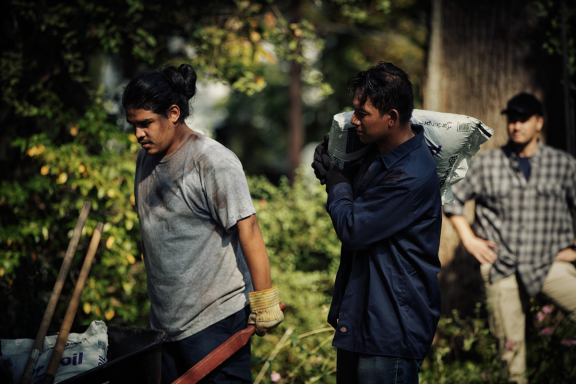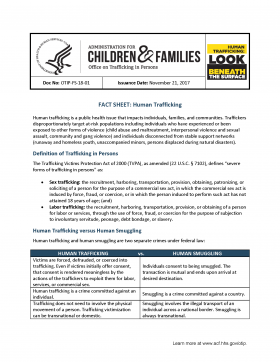What Is Human Trafficking?

In addition to being a violent crime, human trafficking is a public health concern that impacts individuals, families, and entire communities across generations. It requires training and a response from communities, social service providers, health care providers, and other first responders.
Human trafficking is a form of modern slavery. It occurs when a trafficker exploits an individual with force, fraud, or coercion to make them perform commercial sex or work.
There are two types of trafficking:
- Labor Trafficking - Individuals are compelled to work or provide services by force, fraud, or coercion.
- Sex Trafficking - Adults are compelled to engage in commercial sex by force, fraud, or coercion. Minors are compelled to perform a commercial sex act regardless of the presence of force, fraud, or coercion.
The legal definition of human trafficking describes three facets of the crime: an action, a means, and a purpose. For example, if an individual is recruited by fraudulent means for the purpose of forced labor, that individual has experienced trafficking.
| action | means (Does not need to be present in a situation of sex trafficking of minors) |
purpose |
|---|---|---|
|
Recruiting includes proactive targeting of vulnerability and grooming behaviors Harboring includes isolation, confinement, monitoring Transporting includes movement and arranging travel Providing includes giving to another individual Obtaining includes forcibly taking, exchanging something for ability to control *Soliciting includes offering something of value *Patronizing includes receiving something of value *Only for sex trafficking |
Force includes physical restraint, physical harm, sexual assault, and beatings. Monitoring and confinement is often used to control victims, especially during early stages of victimization to break down the victim’s resistance. Fraud includes false promises regarding employment, wages, working conditions, love, marriage, or better life. Over time, there may be unexpected changes in work conditions, compensation or debt agreements, or nature of relationship. Coercion includes threats of serious harm to or physical restraint against any person, psychological manipulation, document confiscation, and shame and fear-inducing threats to share information or pictures with others or report to authorities. |
Commercial Sex Act is any sex act on account of anything of value given to or received by any person. Involuntary Servitude is any scheme, plan, or pattern intended to cause a person to believe that, if the person did not enter into or continue in such condition, that person or another person would suffer serious harm or physical restraint; or the abuse or threatened abuse of the legal process. Debt Bondage includes a pledge of services by the debtor or someone under debtor’s control to pay down known or unknown charges (e.g. fees for transportation, boarding, food, and other incidentals; interest, fines for missing quotas, and charges for “bad behavior). The length and nature of those services are not respectively limited and defined, where an individual is trapped in a cycle of debt that he or she can never pay down. Peonage is a status or condition of involuntary servitude based on real or alleged indebtedness Slavery is the state of being under the ownership or control of someone where a person is forced to work for another. |
Targeted individuals are not limited to any class, religious, cultural, or ethnic group. The venues also vary from illicit markets to legal industries like hospitality, construction, or domestic services. Traffickers can be any gender or age — some are strangers, while others are peers, friends, romantic partners or family members.
 Vulnerable Populations
Vulnerable Populations
- Individuals who have experienced childhood abuse or neglect
- Children involved in the foster care and juvenile justice systems
- Runaway and homeless youth
- Native Americans, Native Hawaiians, and Pacific Islanders
- Victims of violence
- Lesbian, Gay, Bisexual, Transgender, and Questioning (LGBTQ) individuals
- Migrant workers
- Undocumented immigrants
- Racial and ethnic minorities
- People with disabilities
- People with low incomes
- Those with a history of substance abuse
- Those communities exposed to intergenerational trauma
Learn more about federal law on human trafficking.




